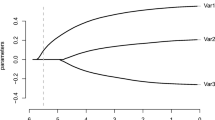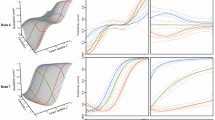Abstract
A new diagnostic tool for the identification of differential item functioning (DIF) is proposed. Classical approaches to DIF allow to consider only few subpopulations like ethnic groups when investigating if the solution of items depends on the membership to a subpopulation. We propose an explicit model for differential item functioning that includes a set of variables, containing metric as well as categorical components, as potential candidates for inducing DIF. The ability to include a set of covariates entails that the model contains a large number of parameters. Regularized estimators, in particular penalized maximum likelihood estimators, are used to solve the estimation problem and to identify the items that induce DIF. It is shown that the method is able to detect items with DIF. Simulations and two applications demonstrate the applicability of the method.








Similar content being viewed by others
References
Agresti, A. (2002). Categorical data analysis. New York: Wiley.
Andersen, E. (1973). A goodness of fit test for the Rasch model. Psychometrika, 38, 123–140. doi:10.1007/BF02291180.
Beck, A., & Teboulle, M. (2009). A fast iterative shrinkage-thresholding algorithm for linear inverse problems. SIAM Journal on Imaging Sciences, 2(1), 183–202.
Bondell, H., Krishna, A., & Ghosh, S. (2010). Joint variable selection for fixed and random effects in linear mixed-effects models. Biometrics, 1069–1077.
Breiman, L. (2001). Random forests. Machine Learning, 45, 5–32.
Breiman, L., Friedman, J.H., Olshen, R.A., & Stone, J.C. (1984). Classification and regression trees. Monterey: Wadsworth.
Bühlmann, P., & Hothorn, T. (2007). Boosting algorithms: regularization, prediction and model fitting (with discussion). Statistical Science, 22, 477–505.
Eilers, P.H.C., & Marx, B.D. (1996). Flexible smoothing with B-splines and penalties. Statistical Science, 11, 89–121.
Fan, J., & Li, R. (2001). Variable selection via nonconcave penalize likelihood and its oracle properties. Journal of the American Statistical Association, 96, 1348–1360.
Friedman, J.H., Hastie, T., & Tibshirani, R. (2010). Regularization paths for generalized linear models via coordinate descent. Journal of Statistical Software, 33(1), 1–22.
Fu, W.J. (1998). Penalized regression: the bridge versus the lasso. Journal of Computational and Graphical Statistics, 7, 397–416.
Hastie, T., Tibshirani, R., & Friedman, J.H. (2009). The elements of statistical learning (2nd ed.). New York: Springer.
Hoerl, A.E., & Kennard, R.W. (1970). Ridge regression: bias estimation for nonorthogonal problems. Technometrics, 12, 55–67.
Holland, P.W., & Thayer, D.T. (1988). Differential item performance and the Mantel-Haenszel procedure. In Test validity (pp. 129–145).
Holland, W., & Wainer, H. (1993). Differential item functioning. Mahwah: Lawrence Erlbaum Associates.
Kim, S.-H., Cohen, A.S., & Park, T.-H. (1995). Detection of differential item functioning in multiple groups. Journal of Educational Measurement, 32(3), 261–276.
Knight, K., & Fu, W. (2000). Asymptotics for lasso-type estimators. Annals of Statistics, 1356–1378.
LeCessie (1992). Ridge estimators in logistic regression. Applied Statistics, 41(1), 191–201.
Lord, F.M. (1980). Applications of item response theory to practical testing problems. London: Routledge.
Magis, D., Beland, S., & Raiche, G. (2013). difR: collection of methods to detect dichotomous differential item functioning (DIF) in psychometrics. R package version 4.4.
Magis, D., Bèland, S., Tuerlinckx, F., & Boeck, P. (2010). A general framework and an R package for the detection of dichotomous differential item functioning. Behavior Research Methods, 42(3), 847–862.
Magis, D., Raîche, G., Béland, S., & Gérard, P. (2011). A generalized logistic regression procedure to detect differential item functioning among multiple groups. International Journal of Testing, 11(4), 365–386.
Mair, P., & Hatzinger, R. (2007). Extended Rasch modeling: the erm package for the application of IRT models in R. Journal of Statistical Software, 20(9), 1–20.
Mair, P., Hatzinger, R., & Maier, M.J. (2012). eRm: extended Rasch modeling. R package version 0.15-0.
Mantel, N., & Haenszel, W. (1959). Statistical aspects of the analysis of data from retrospective studies of disease. Journal of the National Cancer Institute, 22(4), 719–748.
Masters, G. (1982). A Rasch model for partial credit scoring. Psychometrika, 47(2), 149–174.
McCullagh, P., & Nelder, J.A. (1989). Generalized linear models (2nd ed.). New York: Chapman & Hall.
Meier, L. (2009). grplasso: fitting user specified models with Group Lasso penalty. R package version 0.4-2.
Meier, L., van de Geer, S., & Bühlmann, P. (2008). The group lasso for logistic regression. Journal of the Royal Statistical Society. Series B, 70, 53–71.
Merkle, E.C., & Zeileis, A. (2013). Tests of measurement invariance without subgroups: a generalization of classical methods. Psychometrika, 78, 59–82.
Millsap, R., & Everson, H. (1993). Methodology review: statistical approaches for assessing measurement bias. Applied Psychological Measurement, 17(4), 297–334.
Ni, X., Zhang, D., & Zhang, H.H. (2010). Variable selection for semiparametric mixed models in longitudinal studies. Biometrics, 66, 79–88.
Nyquist, H. (1991). Restricted estimation of generalized linear models. Applied Statistics, 40, 133–141.
Osborne, M., Presnell, B., & Turlach, B. (2000). On the lasso and its dual. Journal of Computational and Graphical Statistics, 9(2), 319–337.
Osterlind, S., & Everson, H. (2009). Differential item functioning (Vol. 161). Thousand Oaks: Sage Publications, Inc.
Park, M.Y., & Hastie, T. (2007). An l1 regularization-path algorithm for generalized linear models. Journal of the Royal Statistical Society. Series B, 69, 659–677.
Penfield, R.D. (2001). Assessing differential item functioning among multiple groups: a comparison of three Mantel-Haenszel procedures. Applied Measurement in Education, 14(3), 235–259.
R Core Team (2012). R: a language and environment for statistical computing. Vienna: R Foundation for Statistical Computing. ISBN 3-900051-07-0.
Raju, N.S. (1988). The area between two item characteristic curves. Psychometrika, 53(4), 495–502.
Rasch, G. (1960). Probabilistic models for some intelligence and attainment tests. Copenhagen: Danish Institute for Educational Research.
Rogers, H. (2005). Differential item functioning. In Encyclopedia of statistics in behavioral science.
Samejima, F. (1997). Graded response model. In Handbook of modern item response theory (pp. 85–100).
Schwarz, G. (1978). Estimating the dimension of a model. The Annals of Statistics, 6, 461–464.
Segerstedt, B. (1992). On ordinary ridge regression in generalized linear models. Communications in Statistics. Theory and Methods, 21, 2227–2246.
Soares, T., Gonçalves, F., & Gamerman, D. (2009). An integrated Bayesian model for dif analysis. Journal of Educational and Behavioral Statistics, 34(3), 348–377.
Somes, G.W. (1986). The generalized Mantel–Haenszel statistic. American Statistician, 40(2), 106–108.
Strobl, C., Kopf, J., & Zeileis, A. (2013). Rasch trees: a new method for detecting differential item functioning in the Rasch model. Psychometrika. doi:10.1007/s11336-013-9388-3.
Strobl, C., Malley, J., & Tutz, G. (2009). An introduction to recursive partitioning: rationale, application and characteristics of classification and regression trees, bagging and random forests. Psychological Methods, 14, 323–348.
Swaminathan, H., & Rogers, H.J. (1990). Detecting differential item functioning using logistic regression procedures. Journal of Educational Measurement, 27(4), 361–370.
Thissen, D., Steinberg, L., & Wainer, H. (1993). Detection of differential item functioning using the parameters of item response models. In P. Holland & H. Wainer (Eds.), Differential item functioning (pp. 67–113). Hillsdale: Lawrence Erlbaum Associates.
Tibshirani, R. (1996). Regression shrinkage and selection via the lasso. Journal of the Royal Statistical Society. Series B, 58, 267–288.
Tutz, G. (2012). Regression for categorical data. Cambridge: Cambridge University Press.
Tutz, G., & Binder, H. (2006). Generalized additive modeling with implicit variable selection by likelihood-based boosting. Biometrics, 62, 961–971.
Van den Noortgate, W., & De Boeck, P. (2005). Assessing and explaining differential item functioning using logistic mixed models. Journal of Educational and Behavioral Statistics, 30(4), 443–464.
Yuan, M., & Lin, Y. (2006). Model selection and estimation in regression with grouped variables. Journal of the Royal Statistical Society. Series B, 68, 49–67.
Zeileis, A., Hothorn, T., & Hornik, K. (2008). Model-based recursive partitioning. Journal of Computational and Graphical Statistics, 17(2), 492–514.
Zou, H., Hastie, T., & Tibshirani, R. (2007). On the “degrees of freedom” of the lasso. The Annals of Statistics, 35(5), 2173–2192.
Zumbo, B. (1999). A handbook on the theory and methods of differential item functioning (dif). Ottawa: National Defense Headquarters.
Acknowledgements
We thank the editor, an unknown reviewer, and Paul De Boeck for their helpful and constructive comments that improved presentation and content.
Author information
Authors and Affiliations
Corresponding author
Appendix
Appendix
Proposition
Let for the parameters of the general model with predictor \(\eta _{pi}=\theta_{p} -\beta_{i}-\boldsymbol {x}^{T}_{p} \boldsymbol {\gamma }_{i}\) be constrained by β I =0, \(\boldsymbol {\gamma }_{I}^{T}=(0,\dots,0)\) and let the matrix X with rows \((1,\boldsymbol {x}^{T}_{1}),\dots,(1,\boldsymbol {x}^{T}_{P})\) have full rank. Then parameters are identifiable.
Proof
Let two sets of parameters that fulfill the constraints be given such that
for all persons and items. From considering item I and person p, one obtains by using \(\beta_{I}=\tilde{\beta}_{I}=0\), \(\boldsymbol {\gamma }_{I}^{T}=\tilde{\boldsymbol {\gamma }}_{I}^{T}=(0,\dots,0)\) \(\theta_{p}=\tilde{\theta}_{p}\). Therefore, one has \(\beta_{i}+\boldsymbol {x}^{T}_{p} \boldsymbol {\gamma }_{i}=\tilde{\beta}_{i}+\boldsymbol {x}^{T}_{p} \tilde{\boldsymbol {\gamma }}_{i}\) for all p, i, which for item i can be written in matrix form as
One can multiply on both sides of the equation with X T, and, since X has full rank, with the inverse (X T X)−1, obtaining \((\beta_{i}, \boldsymbol {\gamma }_{i})^{T}=(\tilde{\beta}_{i}, \tilde{\boldsymbol {\gamma }}_{i})^{T}\). Alternatively, one can use the single value decomposition of X. □
Rights and permissions
About this article
Cite this article
Tutz, G., Schauberger, G. A Penalty Approach to Differential Item Functioning in Rasch Models. Psychometrika 80, 21–43 (2015). https://doi.org/10.1007/s11336-013-9377-6
Received:
Published:
Issue Date:
DOI: https://doi.org/10.1007/s11336-013-9377-6




